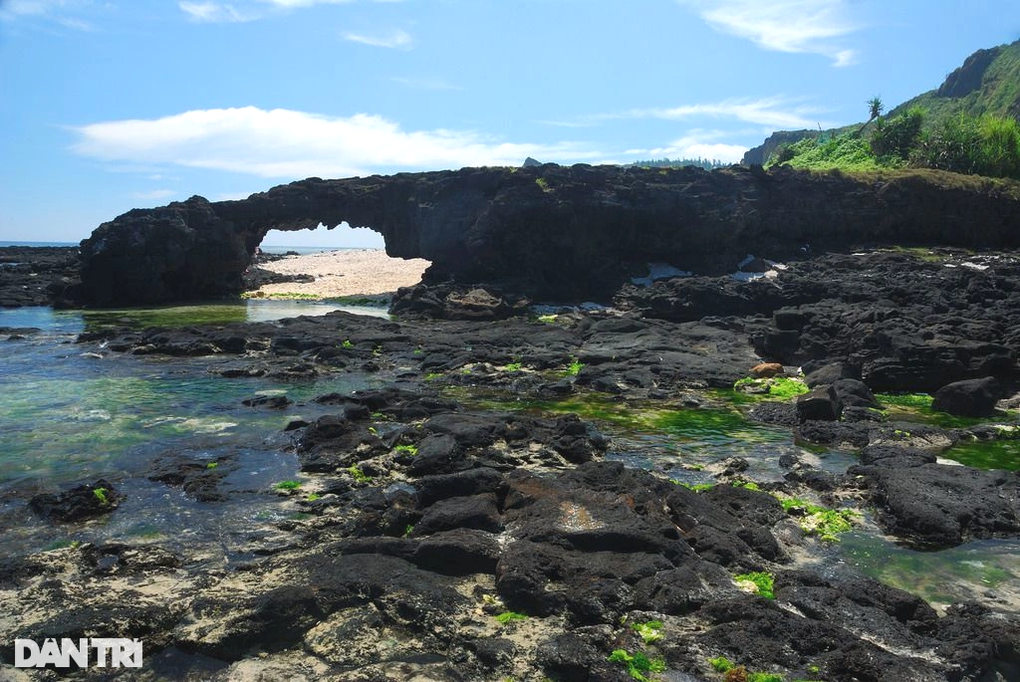On September 10, information from the Department of Culture, Sports and Tourism of Quang Ngai province said that To Vo gate in Ly Son special zone was ranked as a national monument by the Ministry of Culture, Sports and Tourism.
To Vo Gate was formed from the eruption of Gieng Tien volcano. This is one of the volcanoes that created Ly Son island. Volcanic lava created a thick basalt layer at the location of To Vo Gate.

To Vo Gate in Ly Son special economic zone (Photo: Quoc Trieu).
Over time, the basalt layer of To Vo gate was broken by sea waves, creating a hole in the middle layer of rock. This hole has the shape of a wasp's nest.
The stone arch of To Vo gate is about 9m long, the top of the gate is 4m higher than the sea-worn surface, and the narrowest point is about 2m wide.
With its wild, unique, distinct, exclusive beauty and high recognition, To Vo Gate has become one of the famous scenic spots of Quang Ngai province and Vietnam.
In addition to the To Vo Gate on land, in the Ly Son sea area there is another stone arch located off the coast of Be Island. This stone arch was discovered by archaeologists in 2014. The stone arch was formed from volcanic lava, with a structure identical to the To Vo Gate on land.
The lava mass that forms the rock arch stretches nearly 100m, of which the dome is about 20m long. From the seabed, the highest point of the rock arch is about 5m.
Ly Son Special Economic Zone is about 15 nautical miles from the mainland, has an area of about 10 square kilometers, and a population of about 22,000 people.
Ly Son Special Economic Zone includes Big Island and Small Island. This area has traces of 10 volcanic craters, of which 3 are located on the seabed.
Source: https://dantri.com.vn/du-lich/vom-da-nui-lua-o-dac-khu-ly-son-tro-thanh-di-tich-quoc-gia-20250910091704862.htm


![[Photo] The 1st Congress of Phu Tho Provincial Party Committee, term 2025-2030](https://vphoto.vietnam.vn/thumb/1200x675/vietnam/resource/IMAGE/2025/9/30/1507da06216649bba8a1ce6251816820)
![[Photo] General Secretary To Lam, Secretary of the Central Military Commission attends the 12th Party Congress of the Army](https://vphoto.vietnam.vn/thumb/1200x675/vietnam/resource/IMAGE/2025/9/30/9b63aaa37ddb472ead84e3870a8ae825)
![[Photo] General Secretary To Lam receives US Ambassador to Vietnam Marc Knapper](https://vphoto.vietnam.vn/thumb/1200x675/vietnam/resource/IMAGE/2025/9/29/c8fd0761aa184da7814aee57d87c49b3)
![[Photo] Solemn opening of the 12th Military Party Congress for the 2025-2030 term](https://vphoto.vietnam.vn/thumb/1200x675/vietnam/resource/IMAGE/2025/9/30/2cd383b3130d41a1a4b5ace0d5eb989d)






























![[Photo] General Secretary To Lam attends the ceremony to celebrate the 80th anniversary of the post and telecommunications sector and the 66th anniversary of the science and technology sector.](https://vphoto.vietnam.vn/thumb/1200x675/vietnam/resource/IMAGE/2025/9/29/8e86b39b8fe44121a2b14a031f4cef46)































































Comment (0)